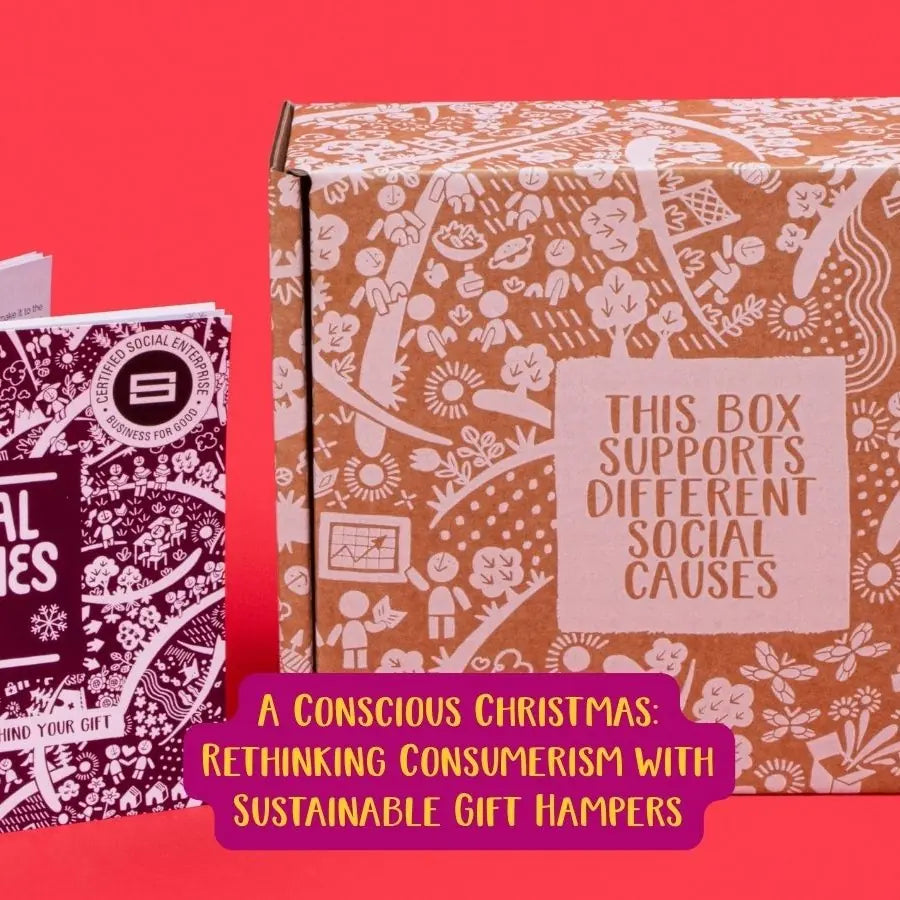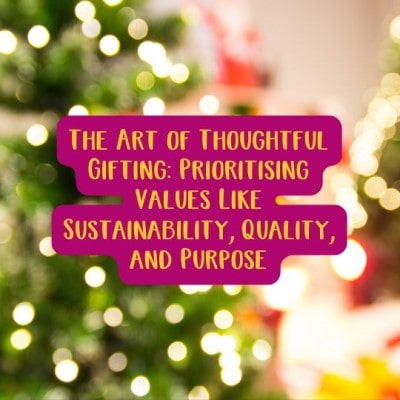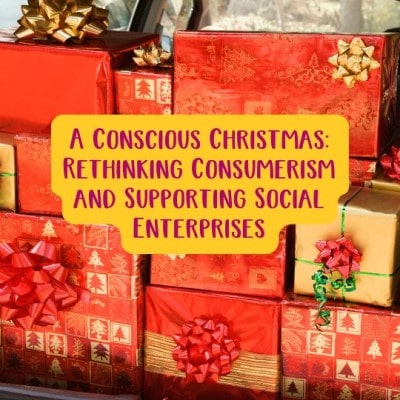
World Chocolate Day - The Ultimate Guide to Sustainable Chocolate: Should I Choose Chocolate in my Sustainable Corporate Christmas Gift?
Social Stories Club creates sustainable gift boxes and has found the most impactful chocolate brands out there. With it being world chocolate day, we wanted to share more about sustainable chocolate practices. With consumers becoming more conscious and aware of their food choices, the demand for sustainable food has never been greater. There are plenty of reasons to be suspicious of chocolate. Cocoa is one of the most highly traded commodities in the world, and much of it is produced by small farmers working under harsh conditions. Child labour, deforestation, and unfair pricing are all real problems in the industry today. While many different food manufacturers are now creating products with sustainability in mind, the chocolate industry has had a vested interest in this movement for some time now. The global demand for chocolate is increasing year-on-year, but unfortunately, we cannot keep up with that demand by relying on conventional methods of production. The world’s cocoa supply is under threat from deforestation, and climate change is also having a detrimental impact on the quality and quantity of cocoa produced worldwide. As a result, the global market needs to find ways to produce and consume sustainable chocolate at scale. Luckily, there are already numerous examples of sustainable chocolate production throughout the world, as well as initiatives dedicated to helping others implement similar methods of production.
What is sustainable chocolate?
Sustainable chocolate is produced using methods that do not deplete natural resources or contribute to deforestation. The cocoa used to make sustainable chocolate is grown on farms that prioritise soil health, water conservation, and biodiversity. Sustainable chocolate also has no synthetic ingredients, and the cocoa farmers are paid a fair wage. Sustainable chocolate is produced with the environment in mind, the farming communities at the forefront, and is made to be environmentally friendly.
Why is sustainable cocoa so important?
Deforestation and poor farming practices can not only affect the farming communities and the environment but can also lead to a global cocoa shortage. This could have disastrous effects on the chocolate industry as we know it. Cocoa is the foundation for chocolate as it makes up about two-thirds of the ingredients in chocolate bars. To keep up with the demand for chocolate, we need to find ways to produce cocoa sustainably and protect the natural resources on which its production depends. The most important resource, in this context, is the soil as the majority of the world’s cocoa is grown in tropical areas, where the soil is fragile and vulnerable.
How can we produce more sustainable cocoa?
The solution to this problem is to support cocoa farmers in producing more sustainable cocoa. To do this, we must first understand the impact of poor farming practices on soil health. One important factor is the use of synthetic fertiliser, which can cause soil acidification and the depletion of important nutrients. Another challenge is the overuse of pesticides, which can reduce biodiversity and pollute the soil and local water sources. When cocoa is produced sustainably, there is no synthetic fertiliser or pesticides used, and soil health is maintained through the use of natural fertilisers and the planting of beneficial plants. Moreover, cocoa farmers are also expected to use sustainable agricultural practices such as reducing water use, protecting wildlife habitats, and engaging with their local communities.

Is there a way to make chocolate 100% sustainable?
Unfortunately, there is no such thing as 100% sustainable chocolate. There are, however, several initiatives that aim to make the chocolate industry as sustainable as possible. One such initiative is the World Cocoa Foundation, which offers resources and certifications for sustainable chocolate. Another initiative is the Rainforest Alliance, which employs the “4-pathway approach” to cocoa sustainability. This approach focuses on improving the quality of cocoa, strengthening relationships between producers and cocoa companies, increasing incomes for cocoa farmers, and improving communities and natural resources.
What are the latest sustainable chocolate trends?
Some of the latest sustainable chocolate trends are the reduction in the use of synthetic fertilisers and pesticides, the implementation of agroforestry practices, the use of sustainable agricultural practices, and the implementation of innovative cocoa-growing methods. The use of synthetic fertilisers and pesticides is a big problem for the cocoa industry, but some producers are now using natural alternatives to reduce their impact. This can, in turn, improve soil health and encourage biodiversity. Another sustainable practice is agroforestry, which encourages the use of trees and other perennials within cocoa fields. This provides shade and improves soil health, while also providing other benefits to the local environment. Chocolate producers are increasingly using sustainable agricultural practices as well. This can include the use of native pollinators to reduce insecticides, the reduction of water use, and the use of cover crops. This helps to protect and improve the soil and water quality, while also improving biodiversity and reducing greenhouse gas emissions.
Is vegan chocolate more sustainable?
Whether or not vegan chocolate is more sustainable than non-vegan chocolate depends on the specific brand. Many non-vegan chocolate companies have begun creating sustainable products, while vegan chocolate brands are also getting involved in the movement. The production of chocolate uses vast amounts of energy, and it takes a large amount of water to grow and process the cocoa beans. Dairy farming is seen to be an unsustainable practice as the dairy cows produce methane, a greenhouse gas. Dairy farms also take a lot of land, which is becoming increasingly scarce in many parts of the world. All of these factors make vegan chocolate a more sustainable option than its dairy-based counterpart. If you are looking for a healthier alternative to traditional chocolate, vegan options are worth considering. In addition to being more environmentally friendly, they are also better for your health. Many vegans choose to avoid dairy products because they contain hormones and other compounds that can interfere with normal hormone function. If you’re concerned about your hormones, choosing vegan chocolate over regular chocolate is a good way to start improving your health right away.
How can we use more sustainable packaging?
Sustainable chocolate packaging is a relatively new concept in the food industry. However, in recent years, it has become more and more popular as consumers are increasingly concerned about the environmental impact of their purchases. Many manufacturers have responded to this growing demand by developing sustainable packaging solutions that reduce waste and carbon emissions while maintaining product quality and freshness. There are several different sustainable packaging options you can choose from when designing your chocolate packaging. All of them aim to do the same thing—reduce the amount of waste that ends up in landfills by reducing the amount of paper, cardboard and plastic used in the production process. The most common types are paperboard and foil.
Paperboard: This traditional packaging material is made from wood pulp fibers that are pressed into thin sheets before being coated with a layer of paper or other materials. It is commonly used for chocolate products because it provides an effective barrier against moisture and oxygen. It is also easy to recycle, which makes it a good option for smaller companies with limited production runs.
Biodegradable or compostable wrappers are a sustainable packaging option that is growing in popularity. There are also recycled paper and cardboard versions, as well as paper clay wrappers. The most common way that chocolate gets wrapped is in plastic, which is bad for the environment because it takes so long to break down. Biodegradable wrappers should be composted or recycled after use, so you can help keep the planet clean while eating some delicious chocolate!
How can cocoa farming practices be more sustainable?
To create sustainable cocoa farming practices, we must first understand the impact of deforestation on cocoa production. Deforestation occurs when forests are cleared for agricultural use, and this can have a huge impact on the quality and quantity of cocoa produced in the region. There are numerous ways that cocoa farmers can create sustainable cocoa growing practices and protect forests. One important factor is the use of shade trees and the maintenance of existing shade trees in cocoa fields. The use of shade trees protects biodiversity, as cocoa is one of many crops that can be grown under the shade of trees. Moreover, shade trees also help to preserve forests, as cocoa growers can plant them around young cocoa trees to prevent deforestation.
What is the biggest opportunity with sustainable chocolate?
Chocolate is one of the most commonly consumed foods in the world. The United Nations Food and Agriculture Organization (FAO) estimates that in 2013, chocolate was the fourth most popular food product in the world after milk, tea, and eggs. Food production and consumption levels have increased significantly over the last century. In 1900, chocolate was only a luxury item for nobility and royalty. Today, it is a staple ingredient in many foods and beverages, both at home and in restaurants. As a result, chocolate consumption has increased significantly as well. In 2013, global chocolate consumption reached an estimated 431 kilograms per capita. This level of consumption is higher than any other single food product except for milk. It also represents a 45% increase from 1980 levels. This is a great opportunity for social enterprise chocolate brands to flourish. As there is already a demand for chocolate, social enterprises may find it easier to get sales and therefore use the proceeds to create a social impact. Social Stories Club which makes sustainable corporate gift hampers find these amazing sustainable chocolate brands such as Chocolate and Love, Divine, and Graces Chocolates and shares the stories in their sustainable gift boxes of how these chocolate brands are creating a positive impact.
Conclusion
The future of the global chocolate industry is bright, but it is up to us to make sure that it remains sustainable. Consumers are increasingly looking to purchase sustainable products, whether that is ethically sourced coffee or responsibly produced chocolate. This is great news for chocolate producers and retailers, as it creates a demand for sustainably sourced products. To keep up with this growing demand, the chocolate industry must find ways to produce more cocoa sustainably and protect the natural resources on which its production depends. The solution to this problem is to support cocoa farmers in producing more sustainable cocoa. To do this, we must first understand the impact of poor farming practices on soil health, and we must also understand the impact of deforestation on cocoa production. Once we have a better understanding of these issues, we can begin to find ways to reduce their impact. To find chocolate brands creating a positive impact, check out the social enterprise Social Stories Club which creates sustainable corporate gift boxes for Christmas, and pick the most impactful chocolate brands to be included inside. If you want to build your own gift box you can select chocolate brands to be included inside.
Read More From Blogs
Every Gift Has a Story: Inside the Sustainable Gifting Company Changing How the UK Gives
Gifting is one of life’s oldest traditions– a way to show gratitude, love, and connection. In a world defined by values, the most meaningful gifts tell a story.
A Conscious Christmas: Rethinking Consumerism with Sustainable Gift Hampers
Companies across the UK spend millions on Christmas presents for staff, clients, and partners, but many of these gifts end up forgotten in drawers.
The Art of Thoughtful Gifting: Prioritising Values Like Sustainability, Quality, and Purpose
The act of gift-giving is a cherished tradition that transcends cultures and generations. It is a way to show appreciation, love, and connection.
A Conscious Christmas: Rethinking Consumerism and Supporting Social Enterprises
The festive season is a time of joy and celebration, but it’s also a period of excess. Each year, millions of people engage in a flurry of spending.




